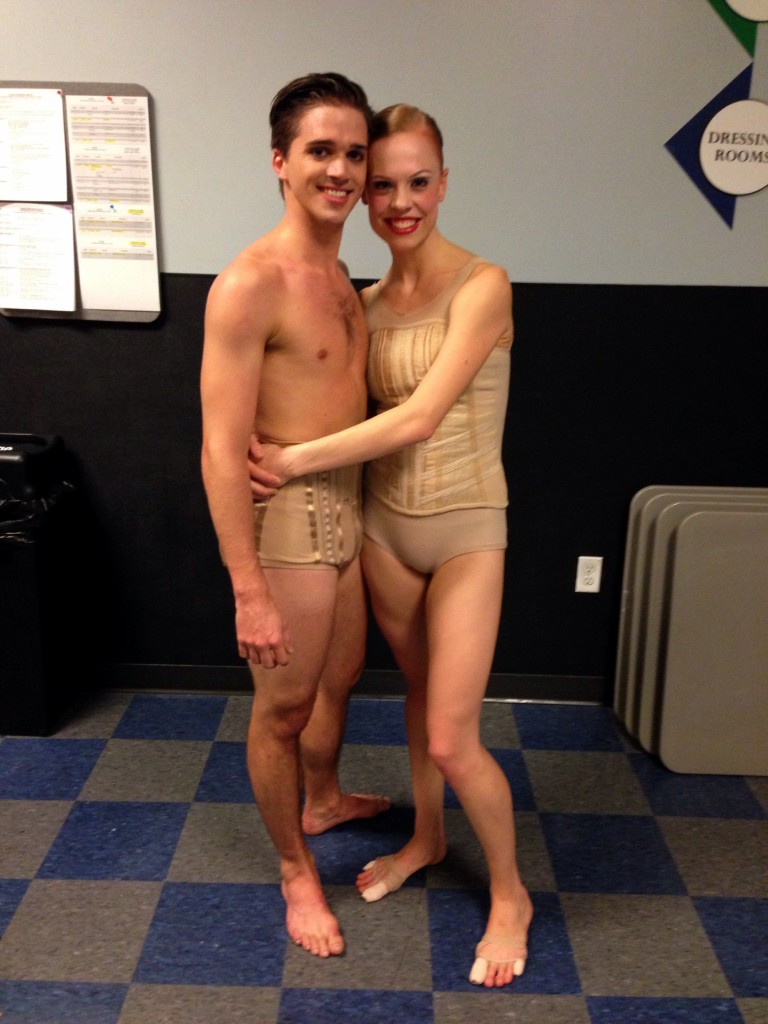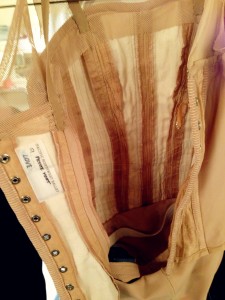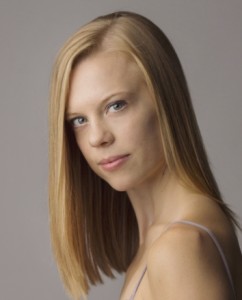
by Emma Love Suddarth
Connection. Between fingertips. Between one note and one arm. Between minds. Between spines. Between you and five other dancers spread across the stage. Between steps. Between dancer and audience. Between details. Between partners. Between souls.
The works of Jiří Kylián are set apart—and rightfully so. The atmosphere of complete intimacy they innately craft, both onstage amongst dancers and across the proscenium with the audience, is unique, and invaluable. At Pacific Northwest Ballet I’ve been lucky enough to perform two already—Sechs Tanze and Petite Mort—and, for the upcoming program Brief Fling, am working to add a third—Forgotten Land. These works hold special places in my heart, not only due to special opportunities, or incomparable partners, but largely due to the joy, trust, intimacy, and fearlessness they inherently create.
My first experience with the work of Kylián came and went in a blur. As a fairly new dancer in the company, simply learning one of the four women of Sechs Tanze was an unbelievable thrill. As a PNB “newbie,” I had no expectation of performing; nevertheless, I was drenched in sweat at the end of every rehearsal because, after all, who wouldn’t want to try being dragged across half the stage in a split, simultaneously going up and down like a carousel, or doing bicycle legs as fast as humanly possible in the air while laying on your partner’s back? It was hard to resist. Then, due to last minute injuries, I got a shot. However, this simultaneously exciting and potentially nerve-wracking experience was different than almost any previous or many since.
In the exposure I’ve had to these works, they are somewhat free of tricks, or “elements,” or those hit-or-miss moments. They are incredibly challenging, and minutely detailed, but their weight stretches throughout, and can’t be placed on a few individual steps or sequences. Their weight lies in relationship—in connection. Not only how does one dancer relate to another, but how does one step relate to the following? It’s so easy to lose sight of the glissade between two steps, or the chassé that actually moves you across half the stage—while one might think it is the photo-moment jumps prior or following.

We focus on the “big things.” And, as dancers in a performance, we often place too much pressure on that one turn, or this landing, or that balance—while the audience (and most times choreographer as well) won’t dock us points if not executed to perfection. Nevertheless, it’s a challenge to let go of that pressure in your mind as you’re entering in. This last-minute opportunity was not that way, and from my partner’s first tap on my shoulder at the beginning of our pas de deux, to yanking my skirt out of his hand at the end of the ballet, I was able invest myself in the interactions that were happening on stage, and the moments that we brought the audience in with us, and the shared joy felt throughout. The choreography, the steps, the world built by Kylián provided that. It was a confidence builder for a young dancer. This experience was a first for me at that point—full presence in the moment on stage, no anxiety about what might loom ahead, no fear of that yet to come, solely uncontainable delight in the present.
Petite Mort was an experience set apart, and one I’ll treasure not only the rest of my career, but the rest of my life. It’s a unique situation—being married to a fellow dancer. It’s not entirely uncommon in the ballet world, with our obscure hours, difficult schedules, and deeply personal careers. It’s something I swore would never be my case, and something now that has blessed me and continues to daily. I will always maintain that the greatest gift my dance career has given me is Price. It’s rare, though, that we actually get to work together. Being virtually the same height (he stakes claim that he’s an inch taller)—me one of the taller women and him one of the shorter men—it’s not as though you’d see us doing finger turns together all that often on stage. However, our boss took a chance and paired us together in this instance—after all, without pointe shoes my giant feet aren’t going to make me that much taller than him, right?
We spent hours in the studio together. As 4th cast among a multitude of principals and soloists, we weren’t under any assumptions that we’d necessarily make it on stage. But, just the deep working on it—the thoughtful rehearsing—provided an unmatched growing and learning experience for us both. Separately, we were each given the chance truly to dig into a piece of choreography, not only with our own wonderful ballet master, as well as an incomparable stager, but with a partner with whom communication was easy. When I say easy, neither of us felt pressure to converse cautiously, or “censor” requests of the other—while that doesn’t imply it was always sunshine and rainbows, it naturally, and seamlessly built the connection requested of the choreography. Those two steps between one lift and the next—how are they to be done? How can they not only connect the two “elements,” but also connect the two of us, and, simultaneously bring the audience into the relationship on stage that we’ve built? We were able to invest ourselves into each detail. It paid off, and we made it on stage. While it was obviously set apart on a multitude of levels—a favorite ballet, a favorite partner—that experience provided invaluable takeaways for myself as dancer, one of the most important being an awareness of connection, between partners and between steps, that I struggle to apply daily.
Standing motionless, barely lit with five other women, hearing the first simple notes of Mozart on the piano, I’ve never been so entirely aware of all senses on stage. I felt the rush of air from the men’s fencing foils. I felt my chest move up and down with every breath. I was simultaneously filled and empty—filled with anticipation, filled with joy, but empty of nerves, empty of uncertainty. I was entirely, wholly present—present in that moment of waiting, in that first touch with Price, and in every step, big or small, that followed. This sensitivity was Kylián’s gift to me, and it’s one I strive to carry with me throughout my career.
See Pacific Northwest Ballet perform Jiří Kylián’s Forgotten Land, part of the lineup in their Brief Fling program, coming up November 4th – November 13th at McCaw Hall. Tickets are still available.

Contributor Emma Love Suddarth is from Wichita, Kansas. She studied with Sharon Rogers and on scholarship at Pacific Northwest Ballet School, and attended summer courses at Central Pennsylvania Youth Ballet, Ballet Academy East, and Pacific Northwest Ballet School. She was first recipient of the Flemming Halby Exchange with the Royal Danish Ballet School and was also a 2004 and 2005 recipient of a Kansas Cultural Trust Grant. She joined Pacific Northwest Ballet as an apprentice in 2008 and was promoted to corps de ballet in 2009.
While at PNB, she has performed featured roles in works by George Balanchine, Peter Boal, David Dawson, Ulysses Dove, William Forsythe, Jiri Kylian, Mark Morris, Margaret Mullin, Crystal Pite, Alexei Ratmansky, Kent Stowell, Susan Stroman, and Price Suddarth. Some of her favorites include the Siren in Balanchine’s The Prodigal Son, Jiri Kylian’s Petit Mort, David Dawson’s A Million Kisses to My Skin, William Forsythe’s New Suite, and Price Suddarth’s Signature.
She is a contributor to Pacific Northwest Ballet’s blog. She is married to fellow PNB dancer Price Suddarth.




